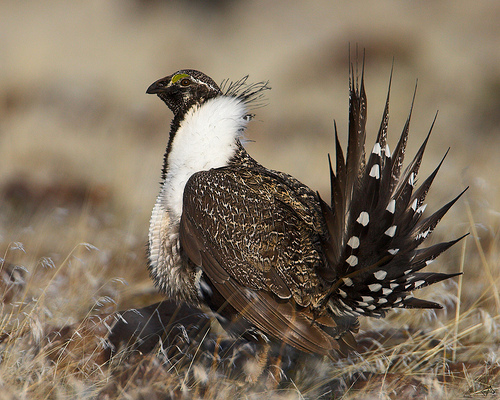I grew up spending the summers at our old family cabin in the middle of sage grouse paradise. I remember thinking the large bird looked like a pharaoh with its bold black neck markings resembling a long goatee. In a sense, the greater sage-grouse is second in line to rule the sagebrush dynasty. But ranchers and energy interests aren’t interested in stepping aside.
In 2010, the U.S. Fish and Wildlife Service gave the sage grouse a designation of “warranted but precluded,” meaning the species qualifies for protection under the Endangered Species Act, but that higher priority species come first. The bright side of this outcome is that it gives groups across the west time to work together to prevent the need for listing.
As reported on NPR this week:
Biologists want to protect the sage grouse, but without starting a 21st century range war over it. So they’ve undertaken a grand experiment in the American West, to keep the grouse happy, as well as cattle ranchers and the energy industry.
The experiment works like this:
- The Sage Grouse Initiative, which includes the Nature Conservancy, state wildlife agencies, and universities, pays ranchers not to develop land—700 ranchers have signed up so far.
- SGI then works with private land owners to remove fences and cut down invasive trees that both push out sagebrush and give hawks and other predators an advantage over the sage grouse.
- The Fish and Wildlife Service issued a report ensuring that the practices of SGI will help restore the sage grouse. Landowners who follow SGI guidelines will be given assurances that they will not be subject to additional restrictions if the species should be listed.
It is too early to tell the outcome of this experiment, but a similar model, “candidate conservation banking,” shows promise for the rare eastern gopher tortoise. In short, a system of positive incentives to motivate environmental stewardship prior to listing under the Endangered Species Act could enhance the nation’s framework for species conservation. It could also remove the perverse incentives landowners often face when threatened species occupy their land.
The spotted owl battle between the timber industry, government, and environmentalists in the 1990s was expensive and drawn-out. As David Naugle says on NPR, the stakes are high here as well—rights to ranching, farming, and oil and gas reserves. “At risk is our nation’s energy security and the ability to provide food on these Western lands,” he says. The Sage Grouse Initiative is one shot at avoiding a battle.




